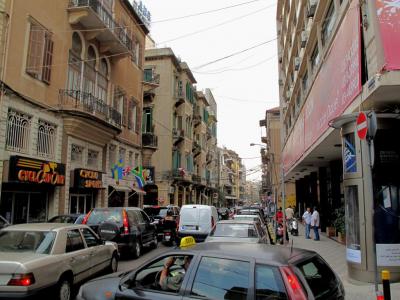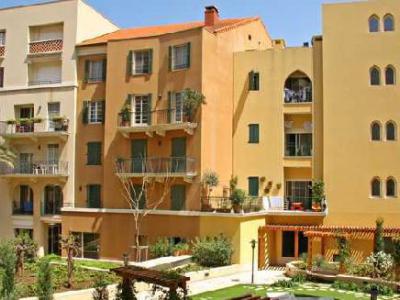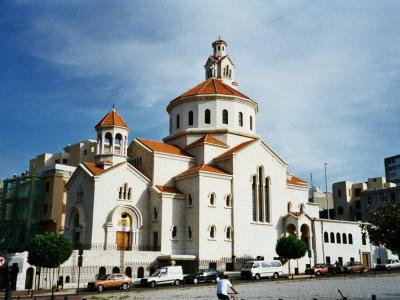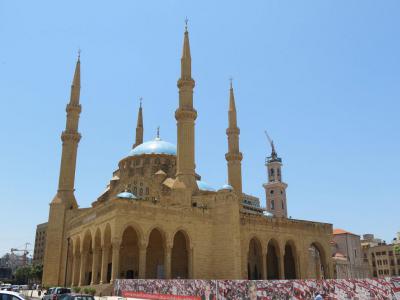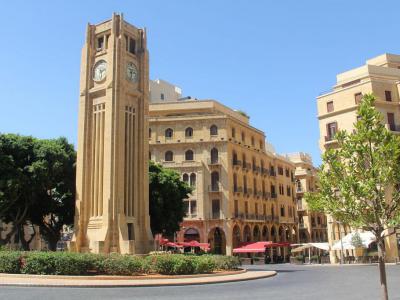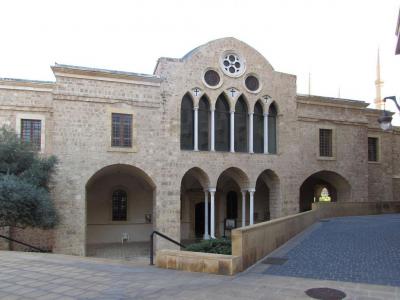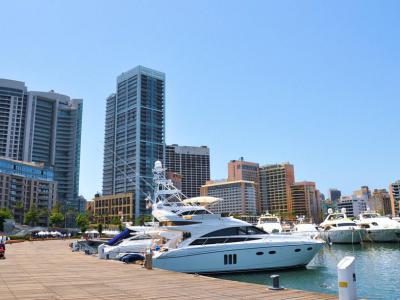
Beirut Introduction Walking Tour (Self Guided), Beirut
How many times can a city die? Beirut, in 5,000 years, has died and come back many times. Archeological digs downtown have revealed Phoenician, Greek, Roman, Byzantine, Arab, Crusader and Ottoman remains and signs of influence.
In 140 BC the city was destroyed by Diodotus Tryphon, a king of the Seleucid Empire. His Hellenistic city lies over the Phoenician one. Pompey the Great arrived in 64 BC and the city was called "Berytus." Berytus was destroyed by the earthquake of 551.
Beirut was conquered by Muslims in 635. Crusaders and Muslims swapped the city back and forth until 1512 when the Ottomans took control. Beirut grew to be the main trading center of the region. The Ottoman period was tumultuous, finally ending after World War I. The French Mandate for Lebanon lasted until 1943.
The civil war, lasting from 1975 until 1990, killed thousands of Lebanese and foreigners and gutted the city. In August 2020 a massive explosion ripped the port, killing over 200 and making thousands homeless. Through all this, the magic and spirit of the city does not die.
The Beirut Central District (BCD) is thousands of years old. It is a center for business, finance, culture, leisure and amusement. Its area covers nearly 51,000 square feet. It has more than 60 gardens and squares, landscaped streets, pedestrian areas and promenades by the sea. There are over 100 cafes, pubs, nightclubs and restaurants, and 350 retail outlets.
The Beirut Souks, the renovated medieval market, has more than 200 stores, restaurants and cafes.
Visit the Mohammad Al Amin Mosque, called the Blue Mosque for its blue tiled domes. The Nicholas Sursock Museum houses modern art. The National Museum of Beirut is the go-to museum for Lebanese archeology. The Neo-classical St George Maronite Cathedral is a restored Greek orthodox church. Martyrs' Square, with its monument to the patriots of 1916, remains.
An old Japanese saying advises, if you fall down seven times, stand up eight times. To visit Beirut is not simply an exciting holiday. It is an adventure of the spirit. Come to the city that always stands up after falling.
In 140 BC the city was destroyed by Diodotus Tryphon, a king of the Seleucid Empire. His Hellenistic city lies over the Phoenician one. Pompey the Great arrived in 64 BC and the city was called "Berytus." Berytus was destroyed by the earthquake of 551.
Beirut was conquered by Muslims in 635. Crusaders and Muslims swapped the city back and forth until 1512 when the Ottomans took control. Beirut grew to be the main trading center of the region. The Ottoman period was tumultuous, finally ending after World War I. The French Mandate for Lebanon lasted until 1943.
The civil war, lasting from 1975 until 1990, killed thousands of Lebanese and foreigners and gutted the city. In August 2020 a massive explosion ripped the port, killing over 200 and making thousands homeless. Through all this, the magic and spirit of the city does not die.
The Beirut Central District (BCD) is thousands of years old. It is a center for business, finance, culture, leisure and amusement. Its area covers nearly 51,000 square feet. It has more than 60 gardens and squares, landscaped streets, pedestrian areas and promenades by the sea. There are over 100 cafes, pubs, nightclubs and restaurants, and 350 retail outlets.
The Beirut Souks, the renovated medieval market, has more than 200 stores, restaurants and cafes.
Visit the Mohammad Al Amin Mosque, called the Blue Mosque for its blue tiled domes. The Nicholas Sursock Museum houses modern art. The National Museum of Beirut is the go-to museum for Lebanese archeology. The Neo-classical St George Maronite Cathedral is a restored Greek orthodox church. Martyrs' Square, with its monument to the patriots of 1916, remains.
An old Japanese saying advises, if you fall down seven times, stand up eight times. To visit Beirut is not simply an exciting holiday. It is an adventure of the spirit. Come to the city that always stands up after falling.
How it works: Download the app "GPSmyCity: Walks in 1K+ Cities" from Apple App Store or Google Play Store to your mobile phone or tablet. The app turns your mobile device into a personal tour guide and its built-in GPS navigation functions guide you from one tour stop to next. The app works offline, so no data plan is needed when traveling abroad.
Beirut Introduction Walking Tour Map
Guide Name: Beirut Introduction Walking Tour
Guide Location: Lebanon » Beirut (See other walking tours in Beirut)
Guide Type: Self-guided Walking Tour (Sightseeing)
# of Attractions: 11
Tour Duration: 2 Hour(s)
Travel Distance: 3.3 Km or 2.1 Miles
Author: rose
Sight(s) Featured in This Guide:
Guide Location: Lebanon » Beirut (See other walking tours in Beirut)
Guide Type: Self-guided Walking Tour (Sightseeing)
# of Attractions: 11
Tour Duration: 2 Hour(s)
Travel Distance: 3.3 Km or 2.1 Miles
Author: rose
Sight(s) Featured in This Guide:
- Martyrs Square
- Rue Gouraud (Gouraud Street)
- Saifi Village (Summer Village)
- Cathedral of Saint Elias and Saint Gregory the Illuminator
- Mohammad Al Amin Mosque (Blue Mosque)
- Grand Serail (Government Palace)
- Roman Baths Ruins
- Place de l'Etoile (Star Square)
- St George Greek Orthodox Cathedral
- Beirut Souks
- Zaitunay Bay
1) Martyrs Square
Today a popular spot for civil gathering and protests, Martyrs' Square in the heart of downtown Beirut is a famous landmark. The historic square took its name to commemorate the martyrs executed there. In 1916, on the orders of Djemal Pasha, Ottoman military ruler of Beirut, sixteen Lebanese men are marched into the ancient seaside square called Freedom Square. The men, Christians, Muslims, intellectuals, journalists and one poet are hung with minimal ceremony.
The square originally was an open area, near the ancient watchtower Burj al Kashef. It was a modern square in 1878. It had gardens, kiosks, fountains and souks. It became the main meeting place of the city.
The first Martyrs Monument was unveiled on 19 December 1930. The sculpture showed two women holding hands over a funeral urn. It was created by Youssef Hoyek, a local sculptor. Called "The Weeping Women", it proved unpopular and it was replaced in 1960 by the current Martyrs Monument of Italian sculptor Marino Mazzacuratti.
During the civil war of 1975-1990 the sqaure itself became the demarcation line dividing the city. In 2020 a devastating explosion in the harbor killed hundreds of people and flattened a large swath of the city. Within days there were demonstrations and riots.
People in general blamed government corruption and neglect. Once again Martyrs Square became the scene of blood and destruction. Many people had lost everything. The one thing that remains around Martyrs square is hope. The spirits of the Martyrs of 1916 still abide. There is always hope.
The square originally was an open area, near the ancient watchtower Burj al Kashef. It was a modern square in 1878. It had gardens, kiosks, fountains and souks. It became the main meeting place of the city.
The first Martyrs Monument was unveiled on 19 December 1930. The sculpture showed two women holding hands over a funeral urn. It was created by Youssef Hoyek, a local sculptor. Called "The Weeping Women", it proved unpopular and it was replaced in 1960 by the current Martyrs Monument of Italian sculptor Marino Mazzacuratti.
During the civil war of 1975-1990 the sqaure itself became the demarcation line dividing the city. In 2020 a devastating explosion in the harbor killed hundreds of people and flattened a large swath of the city. Within days there were demonstrations and riots.
People in general blamed government corruption and neglect. Once again Martyrs Square became the scene of blood and destruction. Many people had lost everything. The one thing that remains around Martyrs square is hope. The spirits of the Martyrs of 1916 still abide. There is always hope.
2) Rue Gouraud (Gouraud Street)
The Gouraud Street, once called "Soho by the Sea", was named for French General Henri Gouraud, who had established the French Mandate of Syria and the State of Lebanon. It is a commercial and residential street in the trendy bohemian area of Beirut called Gemmayzeh. The district has narrow streets and buildings from the French era.
The Gemmayzeh neighborhood has more than its share of fashionable bars, cafes, lounges, and restaurants and most of these can be found on the Gouraud Street. The street is east of the city's Central District and north of the upscale, high-maintenance Saifi Village (Summer Village). It extends from Avenue Haddad to the promenade of the Corniche de Fleuve (Corniche River).
The sobriquet "Soho by the Sea" was awarded by Travel and Leisure magazine in 2004. The title fits it perfectly. It is colorful and chic, and it has very fifties style tenements. Next to the street are the Saint Nicholas Stairs, aka "Escalier de l'Art"(Stairway Art). The Stairs are the venue for art festivals each year. They also lead to Monnot street, named after French Jesuit Father Ambroise Monnot, and the Summer Village.
Spoiler alert. Both street Gouraud and the Gemmayzeh district suffered heavy damages in the horrible 2020 explosion. They will come back better than before.
The Gemmayzeh neighborhood has more than its share of fashionable bars, cafes, lounges, and restaurants and most of these can be found on the Gouraud Street. The street is east of the city's Central District and north of the upscale, high-maintenance Saifi Village (Summer Village). It extends from Avenue Haddad to the promenade of the Corniche de Fleuve (Corniche River).
The sobriquet "Soho by the Sea" was awarded by Travel and Leisure magazine in 2004. The title fits it perfectly. It is colorful and chic, and it has very fifties style tenements. Next to the street are the Saint Nicholas Stairs, aka "Escalier de l'Art"(Stairway Art). The Stairs are the venue for art festivals each year. They also lead to Monnot street, named after French Jesuit Father Ambroise Monnot, and the Summer Village.
Spoiler alert. Both street Gouraud and the Gemmayzeh district suffered heavy damages in the horrible 2020 explosion. They will come back better than before.
3) Saifi Village (Summer Village)
Summer Village is at the edge of the City Center. It is bordered by Streets Debbas, Haddad and Gouraud in the south east and north and by Streets Ariss and Kanaani in the west. It used to be the beginning of the Green Line, the front line in the Lebanese Civil War in Beirut. The war had effectively obliterated the neighborhood.
The neighborhood was reconstructed in a style that recalls buildings of the French colonial era. The rebuild was planned by a French architect, developer, and urban planner Francois Spoerry. The overall style is New-Urbanist. The idea is to create pedestrian-friendly neighborhoods having a broad range of housing types and businesses. The streets and modern buildings of Summer Village fit well.
Summer Village is also called Le Quartier des Arts (Art District). It has a number of important art galleries, antique shops and artisan boutiques. Every Saturday, there is an open-air farmers market in the Village square known as "Souk el Tayeb" ("The Good Market"). The market features organic produce and other country fare.
The neighborhood was reconstructed in a style that recalls buildings of the French colonial era. The rebuild was planned by a French architect, developer, and urban planner Francois Spoerry. The overall style is New-Urbanist. The idea is to create pedestrian-friendly neighborhoods having a broad range of housing types and businesses. The streets and modern buildings of Summer Village fit well.
Summer Village is also called Le Quartier des Arts (Art District). It has a number of important art galleries, antique shops and artisan boutiques. Every Saturday, there is an open-air farmers market in the Village square known as "Souk el Tayeb" ("The Good Market"). The market features organic produce and other country fare.
4) Cathedral of Saint Elias and Saint Gregory the Illuminator
The Romanesque Revival Cathedral of Saint Elias and Saint Gregory the Illuminator is located near the district of Saifi, in Beirut, just off Charles Malek Avenue. The cathedral was preceded by earlier churches at this location in 1860. Funding for the Cathedral was provided by Pope Pius XI in 1928.
In 1950 the church was demolished on the order of Cardinal Aghajatian to be replaced by the Romanesque cathedral. The cathedral was completed by 1959 only to be heavily damaged in the civil war. It was renovated after the end of the war in 1990. Services are held twice on Sundays.
Saint Gregory is the 4th century patron saint of Armenia. He was one of the founders of the Armenian Apostolic Church. His relics, including body parts, are scattered all over the old Roman Empire. His head is somewhere in Armenia. His left hand is in the Echmiadzin Cathedral of Armenia. The right hand is in Antelias, Lebanon.
St Elias is popular among Christians, Muslims and Jews. There are nearly three hundred shrines dedicated to him in Lebanon. He is an old time prophet from the 9th century BC who did battle against Baal, the ancient deity of Phoenicia.
The cathedral is within easy walking distance of other religious sites, like St Elija Greek Catholic Church, St George Greek Orthodox Cathedral, St Louis Church of the Capuchins, al Omari Mosque, Mohammad al Amin Mosque, and others.
In 1950 the church was demolished on the order of Cardinal Aghajatian to be replaced by the Romanesque cathedral. The cathedral was completed by 1959 only to be heavily damaged in the civil war. It was renovated after the end of the war in 1990. Services are held twice on Sundays.
Saint Gregory is the 4th century patron saint of Armenia. He was one of the founders of the Armenian Apostolic Church. His relics, including body parts, are scattered all over the old Roman Empire. His head is somewhere in Armenia. His left hand is in the Echmiadzin Cathedral of Armenia. The right hand is in Antelias, Lebanon.
St Elias is popular among Christians, Muslims and Jews. There are nearly three hundred shrines dedicated to him in Lebanon. He is an old time prophet from the 9th century BC who did battle against Baal, the ancient deity of Phoenicia.
The cathedral is within easy walking distance of other religious sites, like St Elija Greek Catholic Church, St George Greek Orthodox Cathedral, St Louis Church of the Capuchins, al Omari Mosque, Mohammad al Amin Mosque, and others.
5) Mohammad Al Amin Mosque (Blue Mosque) (must see)
The Mohammad Al Amin Mosque, commonly called "the Blue Mosque", is the largest mosque in Lebanon. In the 19th century a "Zawiya", a prayer corner named for Sheik Abu Nasr al-Yafi was built on the present site of the mosque on Martyrs Square. In the 1950s it was decided to replace the prayer corner with a mosque.
There were many delays for lack of funds. Finally, after a donation by former Prime Minister Rafic Hariri, the cornerstone was laid in 2002. The mosque covers 11,000 square meters. The blue dome is 48 meters high and its four minarets reach a height of 65 meters each. Its architectural style is similar to the Sultan Ahmed Mosque of Istanbul.
The mosque has several domes. All of the domes are finished with light blue tiles, hence the name "Blue Mosque." There are very high arches, some reaching several stories. Hariri chose Oger Liban and Azmi Fakhuri as architects. Most of the stone used for the building is Yellow Riyadh Stone. Hariri helped with much of the exterior decor.
The interior of the dome is well lighted in the day by square windows circling the dome. A great chandelier hangs in front of the mihrab, the niche indicating the direction of Mecca. The chandelier adds a significant amount of light within the dome. The height of the minarets assist in the propagation of the sound of the Azan, the summons to prayer.
Prime Minister Hariri was assassinated on February 14, 2005. He was laid to rest within Martyrs Square, next to the mosque. The mosque was damaged by the great explosion of august 2020. Chandeliers and windows were smashed but the building remained intact.
The mosque served as the site of funeral rites for Rafic Hariri. It has become a bit of symbolic architecture and the venue for many political and economic events in Lebanon.
There were many delays for lack of funds. Finally, after a donation by former Prime Minister Rafic Hariri, the cornerstone was laid in 2002. The mosque covers 11,000 square meters. The blue dome is 48 meters high and its four minarets reach a height of 65 meters each. Its architectural style is similar to the Sultan Ahmed Mosque of Istanbul.
The mosque has several domes. All of the domes are finished with light blue tiles, hence the name "Blue Mosque." There are very high arches, some reaching several stories. Hariri chose Oger Liban and Azmi Fakhuri as architects. Most of the stone used for the building is Yellow Riyadh Stone. Hariri helped with much of the exterior decor.
The interior of the dome is well lighted in the day by square windows circling the dome. A great chandelier hangs in front of the mihrab, the niche indicating the direction of Mecca. The chandelier adds a significant amount of light within the dome. The height of the minarets assist in the propagation of the sound of the Azan, the summons to prayer.
Prime Minister Hariri was assassinated on February 14, 2005. He was laid to rest within Martyrs Square, next to the mosque. The mosque was damaged by the great explosion of august 2020. Chandeliers and windows were smashed but the building remained intact.
The mosque served as the site of funeral rites for Rafic Hariri. It has become a bit of symbolic architecture and the venue for many political and economic events in Lebanon.
6) Grand Serail (Government Palace)
Ibrahim Pasha of the Egyptian military discovered the hill in 1831 when he had briefly expelled the Ottoman occupiers from Beirut. Ibrahim Pasha liked the hill. It was ideally situated away from the crowded city and it overlooked the sea. The Ottomans returned in 1840. They also liked the hill. It was a great spot for a military base.
Today the Serail Hill is the site of the old Ottoman barracks, the Serail. It sits in downtown Beirut, a few blocks away from the Lebanese Parliament building. The Grand Serail is the most important of the three Ottoman monuments on the hill. The other two are the Council for Development and Reconstruction (CDR) and the Hamidiyyeh clock tower.
In 1853 the Ottoman government began fortifications. Final modifications of the Serail were made by 1894. Sultan Abdulaziz had added a hospital in 1865. The hospital had two wings for an infirmary and an apothecary. In 1918 The French turned the hospital into a courthouse. The site is now the Institute of Fine Art of the Lebanese University.
The architecture of the Serail is akin to the austere facade of the Selimiye Barracks of Istanbul. There are two high-ceiling levels with a facade more than 260 feet long. The east side has a portico arcade with two wings. Each wing has three rows of 16 windows. The four wings of the Serail enclose a courtyard with a limestone fountain.
The facades, inside and out, have 588 arches and arcades. The style of arches include lobed, pointed, rounded and mandolin. There are 92 pointed arcades. The Serail is currently the Office of the President of the Council of Ministers of Beirut.
Former Primte Minister Rafic Hariri installed a plaque over the entrance arch reading: "If political rule lasts perpetually for anyone, it would not have reached you."
Today the Serail Hill is the site of the old Ottoman barracks, the Serail. It sits in downtown Beirut, a few blocks away from the Lebanese Parliament building. The Grand Serail is the most important of the three Ottoman monuments on the hill. The other two are the Council for Development and Reconstruction (CDR) and the Hamidiyyeh clock tower.
In 1853 the Ottoman government began fortifications. Final modifications of the Serail were made by 1894. Sultan Abdulaziz had added a hospital in 1865. The hospital had two wings for an infirmary and an apothecary. In 1918 The French turned the hospital into a courthouse. The site is now the Institute of Fine Art of the Lebanese University.
The architecture of the Serail is akin to the austere facade of the Selimiye Barracks of Istanbul. There are two high-ceiling levels with a facade more than 260 feet long. The east side has a portico arcade with two wings. Each wing has three rows of 16 windows. The four wings of the Serail enclose a courtyard with a limestone fountain.
The facades, inside and out, have 588 arches and arcades. The style of arches include lobed, pointed, rounded and mandolin. There are 92 pointed arcades. The Serail is currently the Office of the President of the Council of Ministers of Beirut.
Former Primte Minister Rafic Hariri installed a plaque over the entrance arch reading: "If political rule lasts perpetually for anyone, it would not have reached you."
7) Roman Baths Ruins
The Roman Baths of the old city of Berytus were discovered in downtown Beirut between Banks Street and Capuchin Street in 1968. One of the baths has been remade as a performance space and a venue for concerts. Mediterranean gardens have also been installed. The gardens grow medicinal herbs and plants once used in the ancient baths.
Ancient Berytus had four large thermae, or bath complexes. The bather would move through rooms with temperatures ranging from cold to hot. The heat was provided by a heating room under the bath floors. Terracotta disks and pipes warmed the air. There were pools of hot and cold water. Finally there was a massage parlor and spaces for music performances.
The baths were important meeting places open to all citizens. The first bath was built in the 1st century AD in the reign of Augustus. The Emperor Hadrian visited the thermae in the 2nd century. The devastating earthquake of 551 AD completely destroyed the baths.
The gardens of the baths of today are actually located in the Garden of Forgiveness. The garden descends through many layers of Beirut's past, to the Roman streets, the Forum, and even an altar from Phoenician times. The area was declared preserved by the Master Plan of the city government.
Ancient Berytus had four large thermae, or bath complexes. The bather would move through rooms with temperatures ranging from cold to hot. The heat was provided by a heating room under the bath floors. Terracotta disks and pipes warmed the air. There were pools of hot and cold water. Finally there was a massage parlor and spaces for music performances.
The baths were important meeting places open to all citizens. The first bath was built in the 1st century AD in the reign of Augustus. The Emperor Hadrian visited the thermae in the 2nd century. The devastating earthquake of 551 AD completely destroyed the baths.
The gardens of the baths of today are actually located in the Garden of Forgiveness. The garden descends through many layers of Beirut's past, to the Roman streets, the Forum, and even an altar from Phoenician times. The area was declared preserved by the Master Plan of the city government.
8) Place de l'Etoile (Star Square)
Nejmeh Square, or Star Square, as otherwise called by the French, is the main square of downtown Beirut. Seen from above, it is roughly in the shape of a star, with six main roads radiating from the center. It is the home of the Art Deco Lebanese Parliament and its adjuncts, two cathedrals, a museum, and restaurants.
In the center of the square is the iconic 1930s Rolex clock tower. The tower was a gift to the city from Mexican-Lebanese emigrant Michel Abed. The tower has four sides with a clock on each side near the top. The square is a tourist magnet also remembered as a convention site for pigeons.
The square is ancient. The world-famous Roman Law School of Berytus is believed to be buried underneath the square, near the St George Greek Orthodox Cathedral. The school was the foremost center of jurisprudence of the Empire. It was lost in the earthquake of 551.
The square was a Levantine souk or marketplace with stalls, kiosks and cafes before the civil war. Everything downtown was erased in the war. Beirut is said to have been destroyed and rebuilt seven times. It is coming back, better than before.
In the center of the square is the iconic 1930s Rolex clock tower. The tower was a gift to the city from Mexican-Lebanese emigrant Michel Abed. The tower has four sides with a clock on each side near the top. The square is a tourist magnet also remembered as a convention site for pigeons.
The square is ancient. The world-famous Roman Law School of Berytus is believed to be buried underneath the square, near the St George Greek Orthodox Cathedral. The school was the foremost center of jurisprudence of the Empire. It was lost in the earthquake of 551.
The square was a Levantine souk or marketplace with stalls, kiosks and cafes before the civil war. Everything downtown was erased in the war. Beirut is said to have been destroyed and rebuilt seven times. It is coming back, better than before.
9) St George Greek Orthodox Cathedral
The cathedral is the oldest operating church in the city. It sits on the remains of the Anastasi Romano-Byzantine Cathedral, which vanished after the earthquake of 551 AD. The Anastasi church was founded by Efstathius in the 5th century. It was located at the edge of Berytus's Roman Law School.
In the 12th century a cathedral was built over the Anastasi site. It was rebuilt after the 1759 earthquake that devastated the Levant area of the Mediterranean world. The rebuilt was declared completed in 1767, but the ceiling collapsed, killing 90 people. Not that many compared to the earthquake, but still. In 1772 the builders tried again.
The new version was built on a cruciform plan. It had three naves, a new portico, a bell tower and the vaulted ceiling was supported by columns. Good idea. In 1783 there were more changes. A narthex was added, the apse enlarged and the gilded iconostasis (altar wall with icons) was installed.
In 1910 the cathedral received a vaulted south portico and the bell tower was moved to the southeast corner. Artist Ibrahim Youssef Saad created lavish frescoes in the interior. The cathedral was bombarded and vandalized in the civil war. In 1995 Metropolitan Elias Audi announced restorations. Restoration was complete in 2003.
A museum was established in the crypt of the cathedral. The museum covers 2,700 square feet. There are exhibits of ancient Christian vessels, ornaments, some of the old altars, mosaics, and the Roman main road. There is also a necropolis with 25 tombs.
The devastating explosion of 2020 caused serious damage to the cathedral, so the cycle of disaster and rebuilding in Beirut continues.
In the 12th century a cathedral was built over the Anastasi site. It was rebuilt after the 1759 earthquake that devastated the Levant area of the Mediterranean world. The rebuilt was declared completed in 1767, but the ceiling collapsed, killing 90 people. Not that many compared to the earthquake, but still. In 1772 the builders tried again.
The new version was built on a cruciform plan. It had three naves, a new portico, a bell tower and the vaulted ceiling was supported by columns. Good idea. In 1783 there were more changes. A narthex was added, the apse enlarged and the gilded iconostasis (altar wall with icons) was installed.
In 1910 the cathedral received a vaulted south portico and the bell tower was moved to the southeast corner. Artist Ibrahim Youssef Saad created lavish frescoes in the interior. The cathedral was bombarded and vandalized in the civil war. In 1995 Metropolitan Elias Audi announced restorations. Restoration was complete in 2003.
A museum was established in the crypt of the cathedral. The museum covers 2,700 square feet. There are exhibits of ancient Christian vessels, ornaments, some of the old altars, mosaics, and the Roman main road. There is also a necropolis with 25 tombs.
The devastating explosion of 2020 caused serious damage to the cathedral, so the cycle of disaster and rebuilding in Beirut continues.
10) Beirut Souks (must see)
Beirut Souks are piazzas and public spaces occupied by 200 shops, 25 restaurants and cafes among landscaped pedestrianized zones. With an entertainment center, a cinema complex, street markets and a coming department store, it is Beirut's busiest shopping and socializing venue.
During the civil war, there were ferocious battles in the city. The Souks area was a ruined no-man's land of snipers, explosions and fires. The battle for the Souks lasted almost three months. Hostilities lasted from 1975 until 1990.
In 1994, Solidere, a private share-holding company, was created by the government to manage reconstruction. Because of political instability, the renewed Souks did not open until 2009. The new Souks are in two parts: the South Souks and the North Souks.
The Souks are designed as interconnected open spaces. The plan follows the period from the Phoenician era to the French Mandate. The Beirut Souks received the 2009 Capital Issues Award for Architectural Excellence.
During the civil war, there were ferocious battles in the city. The Souks area was a ruined no-man's land of snipers, explosions and fires. The battle for the Souks lasted almost three months. Hostilities lasted from 1975 until 1990.
In 1994, Solidere, a private share-holding company, was created by the government to manage reconstruction. Because of political instability, the renewed Souks did not open until 2009. The new Souks are in two parts: the South Souks and the North Souks.
The Souks are designed as interconnected open spaces. The plan follows the period from the Phoenician era to the French Mandate. The Beirut Souks received the 2009 Capital Issues Award for Architectural Excellence.
11) Zaitunay Bay (must see)
Zaitunay Bay is a harbor project, recently completed, around Beirut Marina. It is a wonderful part of town to explore, walk the promenade and people watch. There are restaurants with Lebanese and international cuisine, cafes and shopping options.
The project is conceived as an urban beach. The Beirut Corniche and the new sea promenade are broadened by overlapping layered platforms resembling sea waves. This modification affords more outdoor public spaces for artworks and exhibitions. The Quayside Restaurant Strip has over 17 restaurants and retail locations.
The strip runs alongside the Beirut Marina from the west border to the Yacht Club in the east. The single floor strip is below street level. The roofs of the strip are made to act as a continuation of the Corniche. The entry plaza, the quayside and the Corniche walkway form terraces resembling a stony "beach" over the cafes and shops.
The Yacht Club part of the development was completed in 2014. The Club has ample mooring space for most vessels. It has a clubhouse and nine club suites with facilities on two levels. On the lower level there is a swimming pool deck with bar, a restaurant, lounge, library, games room and gym.
The best time to visit Zaitunay Bay is in early evening when the setting sun illuminates the Mediterranean Sea.
The project is conceived as an urban beach. The Beirut Corniche and the new sea promenade are broadened by overlapping layered platforms resembling sea waves. This modification affords more outdoor public spaces for artworks and exhibitions. The Quayside Restaurant Strip has over 17 restaurants and retail locations.
The strip runs alongside the Beirut Marina from the west border to the Yacht Club in the east. The single floor strip is below street level. The roofs of the strip are made to act as a continuation of the Corniche. The entry plaza, the quayside and the Corniche walkway form terraces resembling a stony "beach" over the cafes and shops.
The Yacht Club part of the development was completed in 2014. The Club has ample mooring space for most vessels. It has a clubhouse and nine club suites with facilities on two levels. On the lower level there is a swimming pool deck with bar, a restaurant, lounge, library, games room and gym.
The best time to visit Zaitunay Bay is in early evening when the setting sun illuminates the Mediterranean Sea.
Walking Tours in Beirut, Lebanon
Create Your Own Walk in Beirut
Creating your own self-guided walk in Beirut is easy and fun. Choose the city attractions that you want to see and a walk route map will be created just for you. You can even set your hotel as the start point of the walk.
Seaside Walking Tour
If you wish to unwind or, perhaps, seek some quality time with your family and friends in a completely safe environment, while in Beirut, the local seaside area offers ample opportunities for both. Lined with palm trees, the city's waterfront guarantees a truly joyful experience and is as much fun for watching the Mediterranean, beautiful people and breathing the air as it is for exploring... view more
Tour Duration: 2 Hour(s)
Travel Distance: 3.2 Km or 2 Miles
Tour Duration: 2 Hour(s)
Travel Distance: 3.2 Km or 2 Miles
The Most Popular Cities
/ view all

